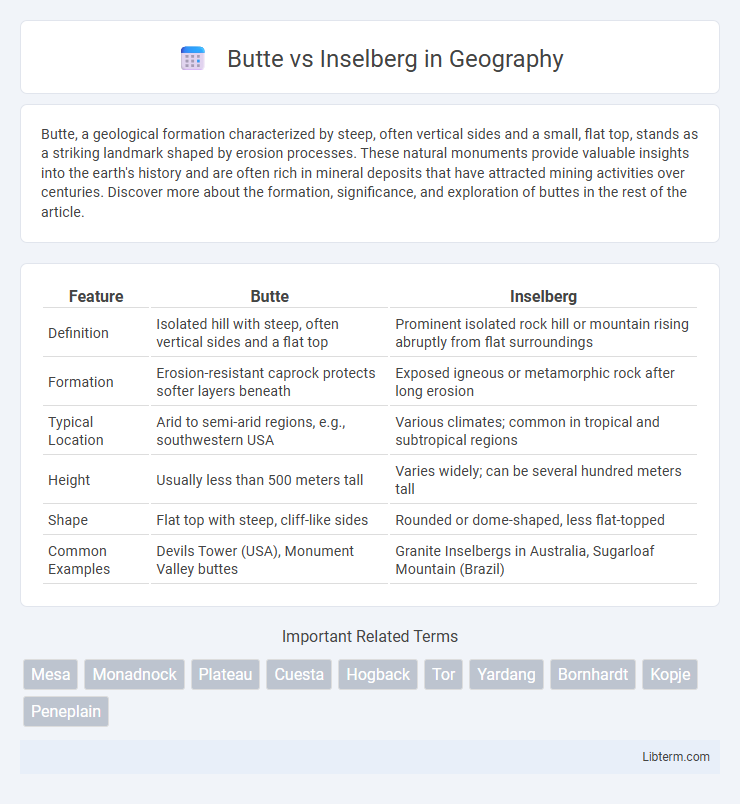Butte, a geological formation characterized by steep, often vertical sides and a small, flat top, stands as a striking landmark shaped by erosion processes. These natural monuments provide valuable insights into the earth's history and are often rich in mineral deposits that have attracted mining activities over centuries. Discover more about the formation, significance, and exploration of buttes in the rest of the article.
Table of Comparison
| Feature | Butte | Inselberg |
|---|---|---|
| Definition | Isolated hill with steep, often vertical sides and a flat top | Prominent isolated rock hill or mountain rising abruptly from flat surroundings |
| Formation | Erosion-resistant caprock protects softer layers beneath | Exposed igneous or metamorphic rock after long erosion |
| Typical Location | Arid to semi-arid regions, e.g., southwestern USA | Various climates; common in tropical and subtropical regions |
| Height | Usually less than 500 meters tall | Varies widely; can be several hundred meters tall |
| Shape | Flat top with steep, cliff-like sides | Rounded or dome-shaped, less flat-topped |
| Common Examples | Devils Tower (USA), Monument Valley buttes | Granite Inselbergs in Australia, Sugarloaf Mountain (Brazil) |
Introduction to Buttes and Inselbergs
Buttes and inselbergs are prominent isolated landforms rising abruptly from surrounding plains, formed through prolonged erosion processes. Buttes typically feature steep, often vertical sides with a flat or gently rounded top, commonly found in arid regions like the American Southwest. Inselbergs, meaning "island mountains," are exposed bedrock hills or small mountains emerging from peneplains, prevalent in tropical and subtropical environments such as parts of Africa and Australia.
Definition and Etymology
A butte is an isolated hill with steep, often vertical sides and a small, relatively flat top, typically found in arid regions and formed through erosion processes. The term "butte" originates from the French word meaning "small hill" or "mound." An inselberg, derived from the German words "Insel" (island) and "Berg" (mountain), refers to an isolated rock hill or mountain rising abruptly from a gently sloping or virtually level surrounding plain, representing an erosional remnant.
Geographical Distribution
Buttes predominantly occur in arid and semiarid regions such as the southwestern United States, including Arizona and Utah, characterized by isolated flat-topped hills with steep sides. Inselbergs are more widely distributed across tropical and subtropical landscapes, with notable occurrences in regions like the African savanna and parts of Australia, representing isolated rock hills that rise abruptly from plains. Both landforms are erosional remnants but differ in their geographical prevalence due to climatic and geological factors influencing landscape evolution.
Formation Processes
Buttes and inselbergs both result from long-term erosion, but their formation processes differ significantly. Buttes form primarily from sedimentary rock layers where harder caprock protects the softer rock beneath from erosion, resulting in steep, isolated hills. Inselbergs, often composed of more resistant igneous or metamorphic rock, emerge as solitary rock hills rising abruptly from flat plains, shaped by extensive chemical and physical weathering processes.
Distinctive Physical Characteristics
Buttes are isolated hills with steep, often vertical sides and a flat top, typically formed by erosion in arid regions. Inselbergs are prominent, exposed rock formations rising abruptly from gently sloping or flat surroundings, usually larger and more rounded than buttes. The key physical distinction lies in the size and shape: buttes are smaller and flat-topped, while inselbergs are massive and dome-shaped or irregularly contoured.
Geological Composition
Buttes and inselbergs differ primarily in their geological composition and formation processes. Buttes consist mainly of sedimentary rock layers, such as sandstone, shale, and limestone, which erode unevenly to create their steep, isolated hills. Inselbergs, often composed of more resistant igneous or metamorphic rocks like granite or gneiss, withstand extensive weathering and erosion that removes surrounding softer material, leaving these prominent rocky outcrops.
Ecological Significance
Buttes and inselbergs serve as unique ecological refuges due to their isolated and distinct microhabitats, supporting specialized flora and fauna not found in surrounding landscapes. Buttes often feature steep slopes that limit human disturbance, allowing for endemic plant species and nesting sites for birds of prey. Inselbergs, as exposed rock outcrops in tropical or subtropical regions, create moisture-retentive niches favoring rare amphibians and drought-resistant vegetation critical for biodiversity conservation.
Famous Examples Worldwide
Famous examples of buttes include the iconic Devils Tower in Wyoming and the Mittens in Monument Valley, Arizona, showcasing isolated, steep-sided hills with flat tops. Inselbergs such as Uluru in Australia and Sugarloaf Mountain in Brazil represent prominent, dome-shaped rock formations rising abruptly from surrounding plains. Both landforms highlight unique geological processes and cultural significance in diverse global landscapes.
Butte vs Inselberg: Key Differences
A butte is a steep, isolated hill with a flat top, often smaller than a mesa, formed by erosion in arid regions. An inselberg is a prominent, solitary rock hill or mountain rising abruptly from a gently sloping or virtually level surrounding plain. Key differences between buttes and inselbergs include their size, formation processes, and geographic settings, with buttes typically associated with sedimentary rock layers and inselbergs linked to resistant igneous or metamorphic rock masses.
Conclusion and Implications
Buttes and inselbergs both represent isolated rock formations but differ fundamentally in scale, formation processes, and geological significance, with buttes typically smaller and shaped by erosion in arid regions, while inselbergs are larger and result from long-term weathering in tropical climates. Understanding these differences aids in interpreting past climatic conditions and landscape evolution, providing valuable insights for geomorphologists and environmental planners. The distinct characteristics of each landform have implications for soil development, biodiversity habitats, and resource management in their respective environments.
Butte Infographic

 libterm.com
libterm.com